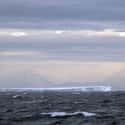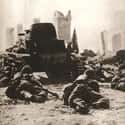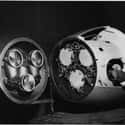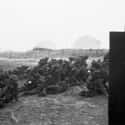-
(#1) Operation Bernhard: The Nazi Plan to Counterfeit Millions in British Banknotes
Operation Bernhard was the Nazi mission to flood wartime Britain with hundreds of millions of counterfeit pound notes. The initiative was orchestrated by SS Major Bernhard Kruger (pictured), who led the SS department falsifying passports and other legal diplomatic documents. Kruger organized a top secret printing operation in the Sachsenhausen concentration camp, made up of specially recruited Jewish prisoners with printing and engraving skills.
During the war, on a monthly basis, Operation Bernhard successfully forged more than a million pounds in bank notes described as "the most dangerous ever seen." Though the Germans never managed to get enough of their fake money into Britain to effect the economy, they used it in a variety of schemes. Fake notes were used to pay spies around the world, and in transactions with foreign governments, such as Italy. Turkish spy Elyesa Bazna, aka Cicero, even (unsuccessfully) sued the German government for fraudulent payments.
At the close of the war, most of the counterfeit currency was dumped into Austria's Lake Toplitz, where it was discovered in 1959. Still, occasional fake British pounds showed up in Britain, prompting the government to redesign all currency with a value of five pounds or more. Some of the currency was smuggled to Palestine, to finance Zionist activity in the early days of Israel.
-
(#2) Operation Tannenbaum: A Nazi Invasion of Switzerland
Adolf Hitler clearly disliked Switzerland. In 1941, he told Mussolini: "Switzerland possessed the most disgusting and miserable people and political system. The Swiss were the mortal enemies of the new Germany."
In fact, the Wehrmacht began preparations for an invasion of Switzerland after France surrendered in 1940, in what would have been called Operation Tannenbaum. Despite the creation of plans for such an invasion (plans revisited and revised several times), Hitler never ordered the attack.
A specific reason for his decision is still unclear, but Swiss financial concessions that allowed the Germans to obtain hard currencies and military equipment, Swiss prevention of the emigration of Jews and other refugees from Germany to Switzerland, continued Nazi access to Swiss railroad routes to Italy and other countries, and the realization that an invasion through the rugged Alpine region defended by a fully mobilized citizenry that was well equipped all were probably factors, especially the latter point. According to PBS, the Swiss armed 435,000 citizens with weapons equal to those the Nazis had, and told them never surrender.
Even though he despised Switzerland, Hitler understood the military reality of any invasion, and a two-front war from 1941 made a Swiss invasion an impossibility.
-
(#3) Project Habakkuk: A British Aircraft Carrier Made of Ice
Geoffrey Pyke was a British inventor who conceived the idea of a floating island the size of an aircraft carrier, to be constructed in the Atlantic Ocean. Theoretically, this island, known as Project Habakkuk, would serve as a refueling location for airplanes stalking and sinking German U-Boats. Initially, tests on icebergs indicated they could be shattered by explosives and were unstable, occasionally rolling over, making them an implausible medium. Undeterred, Pyke invented a new substance made ice and wood pulp called "Pykrete," which could be manipulated like wood.
Lord Mountbatten and Winston Churchill became interested in the project, and a small, 60-by-30 foot block of pykrete was constructed in Lake Louise, Alberta. It weighed 1,000 tons. The estimated weight of a full scale version, as well as the cost, doomed the project, though its creators kept this information concealed to keep Habakkuk viable. The US Navy officially discontinued the project in December of 1943
-
(#4) The Bat Bomb: American's Plan to Burn Down Japan with the Help of Winged Beasts
The bat bomb was a four foot long, bomb-shaped weapon designed to release hundreds of bats fitted with tiny incendiary devices over Japan. Upon release, these bats would spread out over a radius of 20 to 40 miles and roost in the highly flammable wood-and-paper buildings of Japanese cities. Their incendiary devices would then ignite, with the aim of creating widespread chaos and destruction.
The inventor of napalm, Louis Fieser, created a tiny explosive, and the Mexican Free-Tailed Bat was selected for implementation. The first tests involving bats and explosives resulted in an accidental fire at an Air Force air base in Carlsbad, NM. Another test was conducted on a mock-up of a Japanese village in Utah. This attempt was deemed more successful, but research on the atomic bomb curtailed this and other far-fetched weapons systems which were ultimately deemed unrealistic.
-
(#5) Operation Downfall: The 1945 Allied Invasion of Japan
The decision to drop the atomic bomb on two Japanese cities in August of 1945 has always been controversial. Also controversial is the contention that Japan would have surrendered without the death and suffering caused by atomic weapons. However, the US military was fully prepared for a conventional invasion of Japan, in the event the A-bomb wasn't dropped.
This invasion, dubbed Operation Downfall, would have had two components, Operations Olympic and Coronet. Olympic would have started on November 1, 1945, and was intended to capture the island of Kyushu. Coronet, the larger of the two efforts, would have focused on capturing Tokyo, with the use of more than 50 divisions of the US military and assistance from British troops. Alternatives to conventional invasion were considered, because casualty estimates for such an invasion ranged from 300,000 to 1,000,000 US servicemen.
Based on the considerable Japanese defense of Okinawa, a fanatical civilian defense effort was expected, and total Japanese casualties were estimated at 10 million, essentially a near-total annihilation of the country's population, as well as Allied POW's on the mainland. Kamikaze aircraft, an issue at Okinawa, would not have to fly great distances to attack the Allied invasion flotilla.
The atomic bombs, while dreadful for those exposed at Hiroshima and Nagasaki, preempted Operation Downfall, which could have precipitated the end of the Japanese people.
-
(#6) Operation Ketsugo: The Japanese Defense of Japan, 1945
Following the Japanese surrender at Okinawa, it was clear, even to the ardent militarists within the Japanese Imperial government, Japanese victory in the Pacific was impossible. Their goal in implementing Operation Ketsugo (Decisive) was to make invasion of the Japanese mainland so costly the Allies would negotiate an armistice instead of attempting to inflict an unconditional surrender.
In anticipation of invasion, the Japanese transferred troops from Manchuria, Korea, and northern Japan to areas they expected Allied forces to strike. They also mobilized the Patriotic Citizens Fighting Corps, which included all healthy men between the ages of 15 and 60 and women between the ages of 17 and 40. In all, some 28 million people were conscripted to oppose invasion.
The Japanese also expected to launch all-out kamikaze attacks with their remaining 10,000 aircraft, submarines, and 2,400 Shin-yo (one man suicide motorboats). Despite formidable manpower, the Japanese were dangerously low on fuel and equipment. Many civilians would have been fighting with bamboo spears and even longbows. The atomic attacks preempted Operation Ketsugo, and undoubtedly saved millions of Japanese lives.
-
(#7) Project Amerika: Nazi Plans to Bomb the US with Long Range Aircraft
The Amerika Project was an initiative to develop a long-range German bomber capable of attacking the United States. According to Nazi Minister of Armaments and War Production Albert Speer, Hitler was obsessed with bombing New York City. Because of this, German designer Willy Messerschmidt worked on several long-range bomber prototypes.
By April of 1942, three prototype models were developed, the Heinkel HE-277, Junkers JU-390, and the ME-264, and a plan was formulated to use these aircraft to attack on the United States. Ultimately, Germany was forced to focus on more realistic rocketry and weapons, and so abandoned more resource-intensive projects like the Amerika program and the atomic bomb. None of the prototypes built for the Amerika program were ever used in battle.
-
(#8) Operation Felix: The Nazi Attack on Gibraltar and Attempt to Make Spain an Axis Power
After Germany conquered France in the Spring of 1940, Hitler turned his attention to the strategic British outpost of Gibraltar on the Iberian peninsula. Plans, dubbed Operation Felix, were drawn to have two German army corps enter Spain through the Pyrenees and launch a land-based attack on Gibraltar. This operation required the agreement of the Spanish dictator Francisco Franco, and Spain's entry into the war as an Axis power.
German officials, including Von Ribbentrop and Hitler, met repeatedly with Franco in an attempt to reach an agreement, to no avail. Spain was economically vulnerable after its civil war, and Franco feared Britain would seize Spanish possessions like the Canary Islands and the Azores if Spain entered the war. Franco demanded Hitler invade the British Isles in order for Spain to join the Axis. Privately, Franco maintained Germany would lose the war, and thus put ludicrous demands on Hitler as a way of saying no without making problems.
Although Germany considered seizing Gibraltar until 1944, Hitler understood he would never be able to convince Franco to cooperate. He once told Mussolini, "I would rather have four of my own teeth pulled then go through a meeting with that man again!"
-
(#9) Project Pigeon: BF Skinner's Pigeon-Guided Missiles
Feathered-brained Project Pigeon was the World War II brainchild of famed psychologist BF Skinner. The plan involved pigeons guiding a glider-like device equipped with an explosive warhead. One to three pigeons would be placed in front of a screen in the nose cone of the craft, and the screen would use lenses to focus on the intended target. If the glider began to drift off target, the pigeons would peck on the screen to activate sensors, which would re-calibrate the craft's flight path.
The National Defense Research Committee, a government agency comprised of technical industry leaders, provided $25,000 in research funding for Project Pigeon. However, the project was canceled in 1944 to focus on higher strategic priorities. However, the idea was revisited by the Navy in 1948 as Project Orcon, though was canceled again in 1953, when advancements in electronics rendered the need for a pigeon driven guidance system superfluous.
-
(#10) Operation Pike: The Allied Plot to Destroy Soviet Oil Fields
Germany's shocking non-aggression pact with the Soviet Union in August of 1939 led the French and British to believe Russian oil would be used to fuel the Nazi war effort. When the Soviets launched invasions of Poland and Finland in the autumn and winter of 1939, Britain and France came to the conclusion the USSR should be considered an enemy, and its vast oil reserves should be destroyed.
Operation Pike was considered throughout early 1940, as France and Britain drew up plans to attack the Caucasus oil fields via strategic bombing from bases in Iran and Syria. Air reconnaissance and the deployment of bomber crews to the Middle East were undertaken, and the Soviets war gamed potential responses. The German invasion of France precluded a attack after the spring of 1940, and the British postponed operations during the Battle of Britain.
The British government once again considered an attack on Soviet oil fields to prevent them from falling into Nazi hands in 1942, but circumstances negated any need for such a mission.
-
(#11) Operation Unthinkable: Allied Plans To Attack the Soviet Union in 1945
Winston Churchill was skeptical of the West's ability to coexist with Joseph Stalin in post-war Europe. To that end, he asked his joint military command to draw up two contingency operations in 1945, both under the heading Operation Unthinkable. The first contingency called for an offensive attack by US and British forces, along with Polish and reconstituted Wehrmacht troops. Such an attack would take place in Dresden, Germany, the exact center of the Soviet lines.
America responded negatively to this idea at the highest levels of government, as failure to win immediately through the element of surprise would mean protracted war with a military disadvantage. Ultimately, Churchill settled on a second contingency, a defensive plan in the event the Soviets exploited the transfer of American troops to the Pacific theater. This plan remained in place throughout the Cold War.
-
(#12) Plan Rubber: An American Invasion of Brazil
Plan Rubber was a proposed US invasion of Brazil focused on airfields in the north of the country. The idea was to prevent Axis forces from gaining a foothold in the western hemisphere via Africa. In 1941, Brazil was a fascist dictatorship led by Getulio Vargas, perceived as sympathetic to Peronist Argentina and the Nazis. Upon entry into the war, the US immediately attempted to assess Brazil's potential alignment with the Nazis and began contingency plans for an invasion.
Northeastern Brazilian cities Fortaleza, Recife, Natal, and Belem were targeted for amphibious invasion by US Marines, designated Plan Rubber. Using potential invasion as a negotiating tool with the Vargas government, the US installed 150 Marine "advisors" in Brazilian airfields. Subsequent American transportation of armaments to the Brazilian government secured Brazil's official alignment with the Allies in August of 1942.
-
(#13) Operation Round Up: A Spring 1943 Invasion of Northern France
Operation Round Up was a plan, drafted in 1942, for British and American troops to invade France in spring 1943. The Allies were under pressure by the Soviets to open a second front in Europe. Dwight Eisenhower proposed an invasion along a lengthy front of the English Channel, ranging from Le Havre to Boulogne, France. However, the Allies didn't have enough equipment or experienced combat personnel to implement such an ambitious plan.
Winston Churchill was opposed to the invasion of France until the Allies possessed overwhelming military superiority. Because of this, Operation Overlord, the D-Day invasion, didn't happen until June, 1944. In favor of Operation Round Up, allied forces focused on vulnerable Mediterranean coastlines, implementing Operation Torch, an invasion of French North Africa.
-
(#14) Operation FS: The Japanese Plan to Isolate and Conquer Australia
Operation FS was the name of a proposed Japanese invasion of Fiji, Samoa, and New Caledonia in August of 1942. If successful, this attack would have been followed by a blockade and attempt to force Australia's surrender. The Japanese deduced an invasion of Australia would be costly and impractical, but wished to eliminate the continent as a potential Allied base and threat to Japanese defenses in the South Pacific. Following the disastrous Japanese naval setback at Midway, the Japanese postponed FS. They remained on the defensive in the South Pacific thereafter, and never seriously threatened Australia again.
-
(#15) Operation Long Jump: The Plot to Assassinate the Big Three in Iran
Operation Long Jump was an alleged Axis plan to assassinate the Allied Big Three of Roosevelt, Stalin, and Churchill at the Teheran Conference of 1943. According to the People's Commissariat for Internal Affairs (NKDV), a Soviet law enforcement agency with ties to its secret police, German intelligence broke an American naval code and learned about a high level meeting in Teheran, Iran. A plan to kill all three Allied leaders was approved by Hitler and assigned to SS commando Otto Skorzeny.
In 1943, a team of six Nazi operatives arrived in Teheran and began transmitting radio messages to Berlin in anticipation of the arrival of Skorzeny and his team. Supposedly, the NKVD had advance knowledge of the plot from their counterintelligence and arrested the advance team, foiling the plot. Stalin informed his Allied counterparts of the mission at the conference; his assertion was met with skepticism, as the only confirmation came from the Soviets. After the war, German intelligence figures, including Skorzeny, denied such a plan ever existed.
New Random Displays Display All By Ranking
About This Tool
Speaking of World War II, this is the most serious war in human history. This war also precipitated many terrifying, brutal wartime plans. There have been many crazy historical figures in the history of the world, and their thoughts and actions have affected the development of history. Especially during the cruel World War II, all countries were fighting stubbornly for victory and survival and implemented a series of war plans.
The random tool lists 15 maniacal World War II plans that never came to fruition in history. It is hard to imagine that if these plans are successful, the world may not be where it is now.
Our data comes from Ranker, If you want to participate in the ranking of items displayed on this page, please click here.

























